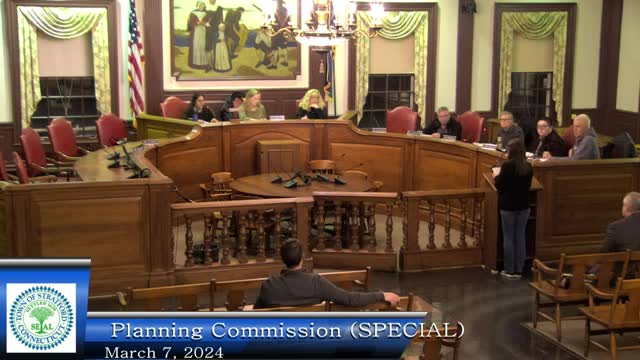Residents demand urgent sidewalk installation on Broadbridge Avenue for safety
March 08, 2024 | Town of Stratford, Fairfield, Connecticut

This article was created by AI summarizing key points discussed. AI makes mistakes, so for full details and context, please refer to the video of the full meeting. Please report any errors so we can fix them. Report an error »

Residents of Stratford are raising urgent concerns about pedestrian safety along Broadbridge Avenue, particularly for vulnerable groups such as the elderly and children. During a recent Town of Stratford Planning Commission meeting, community members highlighted the dangers posed by the lack of sidewalks and safe crossing points on this busy four-lane road.
One resident described the perilous journey faced by those trying to reach the nearest crosswalk, which requires navigating muddy lawns littered with debris or walking directly in the street. This situation is especially hazardous for individuals using wheelchairs or parents pushing strollers. The absence of safe waiting areas for children at bus stops further exacerbates the risk, as they often wait in the street, exposed to fast-moving traffic.
The community member emphasized that the need for a sidewalk is critical, noting that several residents have already been injured while attempting to cross Broadbridge Avenue. They urged the Planning Commission to prioritize the installation of a sidewalk, arguing that the costs would be covered by a developer who had previously committed to this improvement. The resident expressed frustration that the project has been delayed, stating, “We need a sidewalk and we need it like, yesterday.”
In addition to the sidewalk issue, the meeting also addressed concerns from residents living near a new development on Stryclic Road. They requested modifications to the landscaping plan, advocating for the planting of smaller trees and the installation of a fence instead, to reduce maintenance and safety risks.
Town Planner Smith acknowledged the community's concerns regarding the lack of sidewalks, agreeing that it is a pressing issue. However, he noted that recent state legislation limits the ability of planning commissions to impose off-site improvements on developers, complicating the situation.
As discussions continue, residents remain hopeful that their voices will lead to actionable solutions that enhance safety and accessibility in their neighborhood. The urgency of these issues reflects a broader need for infrastructure improvements that prioritize the well-being of all community members.
One resident described the perilous journey faced by those trying to reach the nearest crosswalk, which requires navigating muddy lawns littered with debris or walking directly in the street. This situation is especially hazardous for individuals using wheelchairs or parents pushing strollers. The absence of safe waiting areas for children at bus stops further exacerbates the risk, as they often wait in the street, exposed to fast-moving traffic.
The community member emphasized that the need for a sidewalk is critical, noting that several residents have already been injured while attempting to cross Broadbridge Avenue. They urged the Planning Commission to prioritize the installation of a sidewalk, arguing that the costs would be covered by a developer who had previously committed to this improvement. The resident expressed frustration that the project has been delayed, stating, “We need a sidewalk and we need it like, yesterday.”
In addition to the sidewalk issue, the meeting also addressed concerns from residents living near a new development on Stryclic Road. They requested modifications to the landscaping plan, advocating for the planting of smaller trees and the installation of a fence instead, to reduce maintenance and safety risks.
Town Planner Smith acknowledged the community's concerns regarding the lack of sidewalks, agreeing that it is a pressing issue. However, he noted that recent state legislation limits the ability of planning commissions to impose off-site improvements on developers, complicating the situation.
As discussions continue, residents remain hopeful that their voices will lead to actionable solutions that enhance safety and accessibility in their neighborhood. The urgency of these issues reflects a broader need for infrastructure improvements that prioritize the well-being of all community members.
View full meeting
This article is based on a recent meeting—watch the full video and explore the complete transcript for deeper insights into the discussion.
View full meeting
